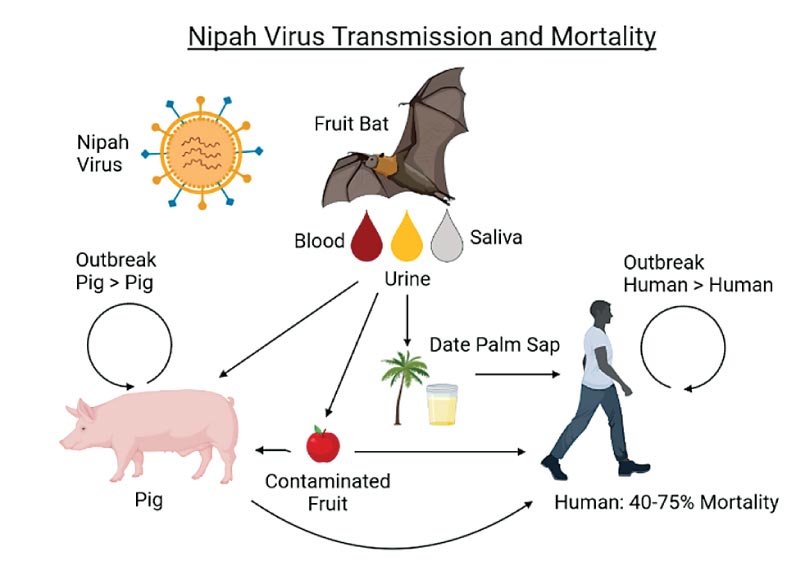Sunday Dec 07, 2025
Sunday Dec 07, 2025
Monday, 25 September 2023 01:26 - - {{hitsCtrl.values.hits}}

By Randima Attygalle
Sri Lankan health authorities urge the public not to panic of a potential Nipah virus outbreak in the country following the two deaths caused by the disease in India’s Southern Kerala. Indian authorities have already instituted mass testing to halt the spread of the zoonotic virus (transmitted from animals to humans). It is the fourth outbreak in the region since 2018.
At the press briefing hosted by the Sri Lanka Medical Association (SLMA) last week, its President, Dr. Vinya Ariyaratne noted that at this point of time, the risk of the virus to Sri Lanka is remote. “COVID-19 has taught the world lessons on pandemic-preparedness and therefore our health authorities are very vigilant on any possible threats.”
Although no international travel restrictions have been imposed at this point of time, travellers to India are advised to take health precautions such as not exposing themselves to animal facilities or consuming contaminated fruits and vegetables.
Nipah virus was first recognised in 1999 during an outbreak among pig farmers in Malaysia. The virus is named after the village where it was discovered. No new outbreaks, however, have been reported in Malaysia since 1999 according to WHO. The virus was also found for the first time in Bangladesh in 2001, and nearly annual outbreaks have occurred in that country since. The disease has also been identified periodically in eastern India. According to WHO, other regions may be at risk for infection, as evidence of the virus has been found in the known natural reservoir (Pteropus bat species) and several other bat species in a number of countries, including Cambodia, Ghana, Indonesia, Madagascar, the Philippines, and Thailand.
During the first recognised outbreak in Malaysia, which also affected Singapore, most human infections resulted from direct contact with sick pigs or their contaminated tissues. Transmission is thought to have occurred through unprotected exposure to secretions from the pigs, or unprotected contact with the tissue of a sick animal.
In subsequent outbreaks in Bangladesh and India, consumption of fruits or fruit products (such as raw date palm juice) contaminated with urine or saliva from infected fruit bats was the most likely source of infection as WHO information reveal. WHO further notes that there are currently no studies on viral persistence in bodily fluids or the environment including fruits. Human-to-human transmission of Nipah virus has also been reported among family and care givers of infected patients.
A majority of Nipah-infected people would develop symptoms including fever, headache, muscle pain, sore throat and dizziness and some could experience pneumonia and severe respiratory problems and even acute encephalitis, Consultant Medical Virologist at the Medical Research Institute (MRI), Dr. Jude Jayamaha told the Daily FT. “The incubation period or the interval from infection to the onset of symptoms could range from 4 to 14 days and in certain cases the incubation period could be longer.” The case fatality as Dr. Jayamaha explained, is estimated at 40% to 75%.
The main diagnostic tool to detect the Nipah virus is the PCT test and the MRI is already collaborating with epidemiologists, the National Institute of Virology and other international collaborators in obtaining PCR kits. “WHO is assisting us to procure these and we are in the process of setting the guidelines and getting ourselves equipped with necessary reagents and protocols in case of a possible threat. However, people need not unnecessarily panic at this point of time,” remarked the Virologist. In terms of treatment, currently there are no specific drugs or vaccines to curb the virus infection and although the virus was first detected nearly 25 years ago, there is only limited scientific data available on the virus, Dr. Jayamaha said further.